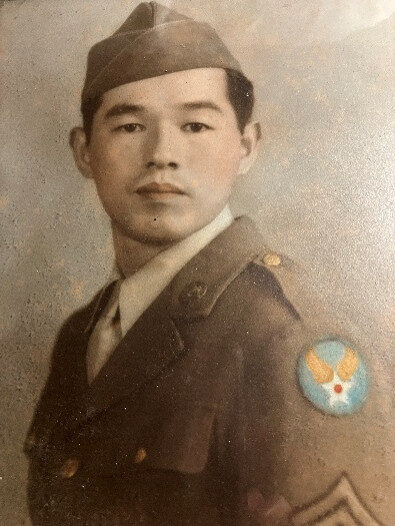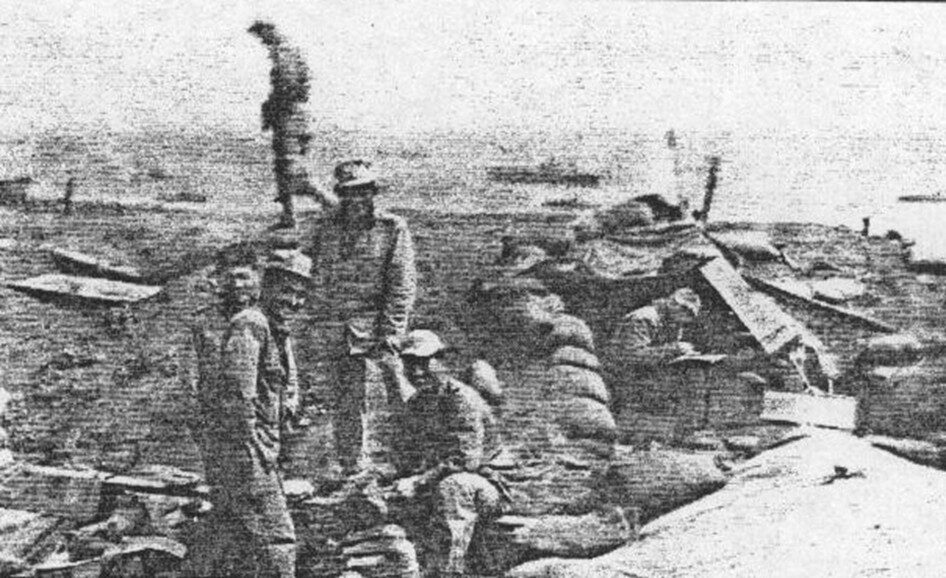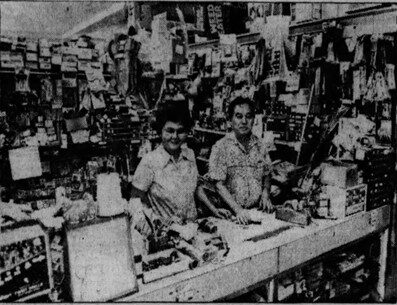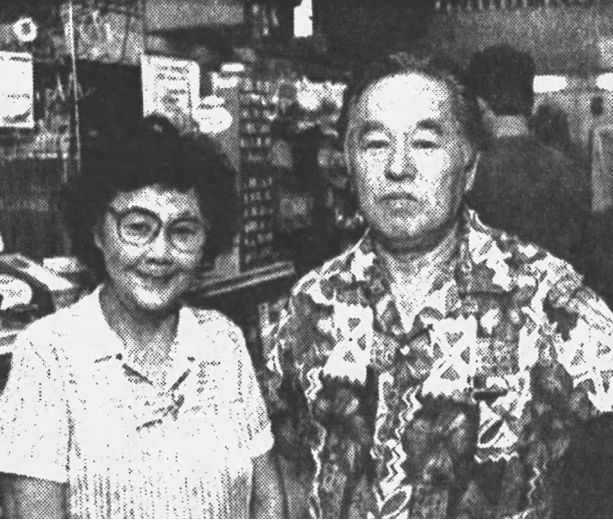Soldier Story: Tsugio Aoyama
Soldier Story

Tsugio Aoyama
Technician 3rd Grade
3rd Battalion, Headquarters Company
442nd Regimental Combat Team
Military Intelligence Service
Tsugio Aoyama was born on February 2, 1920, in Honolulu, Territory of Hawaii. He and his older brother Masuo were born to Juichi and Masu (Kawaguchi) Jo of 321 Kukui Street.
Father Juichi arrived on the S.S. Doric on March 8, 1907, at the age of 19 from the village of Kawahara, Kikuchi District, Kumamoto Prefecture, Japan. His dream was to start a taxi business.
In 1910, Juichi was a lodger in the home of Bunki and Hatsuyo Aoyama at 712 Fort Street. The Aoyamas had no children and operated a clothes cleaning shop, where Juichi was employed. The following year, Juichi was living at 232 South Beretania Street and employed at the Oahu Clothes Cleaning Company.
Mother Masu Kawaguchi Jo had arrived with her husband Juichi on the Korea Maru on March 6, 1917, age 23. They were from the same village and Juichi had returned to Japan to marry her. Juichi was employed as a clothes cleaner for the Oahu Clothes Cleaning Company. Their first child, son Masuo, was born on November 30, 1917, a few months after their arrival.
In 1920, Juichi and Masu were living at 1304 Fort Street with their two sons, Masuo and Tsugio. Juichi was employed as a chauffeur for a garage.
On October 16, 1928, Juichi arrived with his two sons on the Shinyo Maru from Japan. He was listed as a farm laborer and the boys were students. They had been visiting in Juichi’s home village.
By 1930, Masuo and Tsugio Jo were living with Bunki and Hatsuyo (Ikemoto) Aoyama at 1304 Fort Street. Bunki was the proprietor of a clothes cleaning shop. About this time, Juichi and his wife Masu returned to Japan. They allowed the Aoyamas to adopt their sons. On October 16, 1934, the boys were officially adopted by Bunki and Hatsuyo and their surnames legally changed from Jo to Aoyama. The court decree was signed by Judge Norman D. Godbold and the notice published in the Honolulu Advertiser.
Bunki and Hatsuyo Aoyama had emigrated from Hiroshima Prefecture in 1906 and 1908, respectively. Bunki was known for going to the docks to meet the arriving ships and help new immigrants from Japan. He sent Tsugio to attend the Methodist-run missionary school, Aoyama Gakuin, in the Shibuya area of Tokyo and went often to visit him.
Tsugio was among the 131 students in the Kotoka division who graduated from Japanese High School in 1938. The commencement exercises were held at the Hongwanji temple on Fort Street at 7:00 p.m. on June 11.
In 1940, Tsugio and father Bunki were listed as “absent” in the household of mother Hatsuyo who was the manager of the Grove Hotel. Father and son were back Japan at the time. Bunki returned without Tsugio, and he died soon after in the Japanese Hospital in Honolulu on October 9, 1940. He was the proprietor of the Grove Hotel and a prominent member of local Japanese society.
Tsugio arrived back in Honolulu on December 26, 1940, on the Tatuta Maru. He had been gone since September 1939, was a student, and staying with his brother Isamu Aoyama in the village of Aga, Kureshi District, Hiroshima Prefecture.
Tsugio Aoyama signed his draft registration card on July 1, 1941, Local Board No. 212, Tax Office Building, Honolulu. His residence was 1633 Nuuanu Avenue and his point of contact was his brother Masuo Aoyama of 1312 Fort Street. Aoyama was 5’6” tall and he weighed 135 pounds. He was a student and also a summer employee at Libby, McNeill, Libby located at the intersection of Kalani and Waiakamilo Road.
He enlisted in the U.S. Army on March 30, 1943, in Honolulu. His papers noted that he had completed one year of college and his civilian occupation was “Hotel and restaurant managers.” He was sent to the “tent city” called Boom Town at Schofield Barracks with the other new volunteers for the 442nd RCT. They sailed on April 4 on the S.S. Lurline for Oakland, California. Upon arrival, they were sent by train across the US to Camp Shelby, Mississippi.
After arrival, he was assigned to 3rd Battalion, Headquarters Company. During basic training, which was from May 10 to August 23, Aoyama was chosen for the Military Intelligence Service. Many of the soldiers thus chosen and reassigned did not want to leave the 442nd, but they had no choice as their Japanese language abilities were needed in the MIS. Japanese American soldiers were not accepted by the MIS until May 1943. About half of the 6,000 Japanese Americans trained by the Army for the MIS during the war were from Hawaii.
Aoyama was sent with other Hawaii soldiers to the MIS language school at Camp Savage, Minnesota, as part of the June Class of 1943. After graduating in December 1943, he and the others were sent to Camp Blanding, Florida, for basic and further training.
After completing training, Aoyama was assigned to an initial MIS team of 17 men, all from Hawaii, who were shipped out in April 1944 for an unknown destination. The others were: William Fujita, Sam Setsuo lsokane, Benjamin Kawahara, Tameo Kawasaki, Tamotsu Koyanagi, Fred Kuga, Jiro Matsui, Nobuo Nagata, Kenneth Nakada, Don Okubo, James Saito, James Shigeta, Tetsuo Shimamoto, Norio Terao, Katsumi Tsutsui, and Henry Yokoyama.
To the men’s surprise, their unknown destination was their home, Hawaii. Upon arrival in Honolulu, they were assigned to Joint Intelligence Center Pacific Ocean Area (JICPOA). The following information regarding the JICPOA is from Nisei Men of JICPOA Annex, by Sam Setsuo Isokane. JICPOA was a joint Army-Navy-Marine rear-echelon intelligence center directing the intelligence war against Japan in the Central Pacific. It was located at Pearl Harbor under Navy command. However, the Navy distrusted the Japanese American soldiers and barred them from access to Pearl Harbor. As a result, the MIS personnel were organized as an Army Detachment and assigned to the JICPOA Annex Group, which was headquartered and housed in a former furniture store building on Kapiolani Boulevard in Honolulu.
This JICPOA Annex Group consisted of 10 officers and 49 NCOs, including Aoyama and the other 16 original men. They were then joined by 32 other MIS soldiers from Hawaii and the mainland. The names of those from Hawaii were: Edward Kawamoto, George Kawamoto, Hisashi Kubota, Raymond Shogo Nagata, Harry Okada, James Tamashiro, Stanley Tanaka, Larry Kazuo Watanabe, Mineo Yamagata, Ben Yamamoto, and Stanley Yamamoto. From the mainland were: Roy Akiyoshi, Terry Doi, Nobuo Furuiye, Shunji Hamano, Joe Harada, Fred Hirano, George lnagaki, Masao Kuroki, William Makino, Thomas Miyagi, Roy Miyata, Pat Morishita, Tad Ogawa, Don Oka, Hitoshi Okimura, John Otani, Tony Sunarnoto, Torao Torakawa, Steve Yagi, Takeshi Yamashita, and James Yoshinobu.
The JICPOA Annex mission and objectives included the translation of captured secret or top-secret Japanese documents, as well as technical manuals and the preparation of psychological warfare activities. Furthermore, three teams received assignments to join the U.S. Marines as interpreters, translators, and interrogators in the Saipan, Tinian, Peleliu, Guam, Palau, Okinawa, and Iwo Jima Campaigns. Those men engaged in psychological warfare, flew over enemy lines, dropped surrender leaflets, and used loudspeakers from the air to urge the Japanese soldiers to surrender.
In February 1945, Aoyama was among 17 MIS men in Hawaii who volunteered for the invasion of Iwo Jima. The men were clothed in Marine uniforms and went ashore in different LSTs with the 40,000-man invasion force on February 19. Each MIS man was assigned to a Marine escort to get him to the 4th Marine Headquarters command post. They were initially pinned down in foxholes on the beach and only 300 yards from the front even five days after landing. They were under constant sniper fire and witnessed vicious hand-to-hand fighting.
Once at the 4th Headquarters command post, the MIS soldiers went to work looking at documents and diaries taken from dead Japanese soldiers and monitoring field radios and even military radio traffic from Tokyo. As soon as they were able, they engaged in efforts to coax enemy soldiers out of the caves in which they were hiding. After the invasion was a success and their interpreter skills were no longer needed, the men all returned to Honolulu.
Below: Aoyama’s comrades, February 1945, Iwo Jima; front clockwise: Ben Kawahara, Tamotsu (“Shorty”) Koyanagi, George Kawamoto, and Tad Ogawa

These details about participation in the invasion of Iwo Jima were part of a Honolulu Star-Bulletin newspaper interview of two of the men – Jimmie Saito and Ben Kawahara – and published the day before the 25th anniversary of the invasion. The other MIS soldiers who were there were: (from Hawaii) Tsugio Aoyama, Terry Doi, George Kawamoto, Shorty Koyanagi, Jiro Matsui, Harry Okada, Butch Terao, Fred Tsutsumi, Mineo Yamagata, Ben Yamamoto, Dr. Henry Yokoyama, and James Yoshinobu; and from the mainland Nobo Furuiye, Tad Ogawa, and Don Oka.
Toward the end of the war, Aoyama married Frances Yoko Osato (born November 25, 1923) on June 10, 1945, in Honolulu. She was the daughter of Yutaka and Naoe (Kanazawa) Osato. Mr. Osato was a teacher at the Makiki Japanese Language School. He was from the village of Shinnoyuki, Ibaraki Prefecture. Naoe was born in Honolulu.
Tec/3 Aoyama was discharged from the U.S. Army on December 16, 1945, at an Army Separation Center on Oahu. His address was 1527-D Nuuanu Avenue, Honolulu.
For his military service in World War II, Tec/3 Tsugio Aoyama earned the: Good Conduct Medal, American Campaign Medal, Asiatic-Pacific Campaign Medal with one bronze star device, and World War II Victory Medal. He was posthumously awarded the Congressional Gold Medal on October 5, 2010, along with the other veterans of the 100th/442nd Regimental Combat Team and Military Intelligence Service. The award states: “The United States remains forever indebted to the bravery, valor, and dedication to country these men faced while fighting a 2-fronted battle of discrimination at home and fascism abroad. Their commitment and sacrifice demonstrates a highly uncommon and commendable sense of patriotism and honor.”
On June 29, 1946, Tsugio and brother Masuo entered into a co-partnership doing business as Uptown Hardware at 1326 Fort Street. A year later, they moved to a larger location on Nuuanu Avenue and their wives joined the business as partners.
In 1950, Tsugio and Frances were living with their eldest daughter and his widowed mother Hatsuyo in the Grove Hotel at 1633 Nuuanu Avenue. Hatsuyo was the hotel’s manager. Tsugio was the proprietor of Uptown Hardware, a retail hardware store located near the Nuuanu Shopping Plaza.
In 1958, the brothers opened a second Uptown Hardware store in Kaneohe. It closed in 1980 when Masuo and his wife Kimiko retired. Masuo died in 1983. The Nuuanu store carried more than just regular hardware store items – everything from sake cups, bird baths, power mowers, clothespins, woks, gas cans, toys, embroidery scissors, Timex watches, rolling pins, and bud vases. The store gained a reputation for not only selling items, but instructing customers how to do home repairs.
Over the years Tsugio and Frances raised a family of one son and three daughters. In the early years they lived above the store – but when the family grew too large they moved to Kailua.
Below: Frances and Tsugio in their store, September 1981

The couple continued to run Uptown Hardware – with sister-in-law Kimiko Aoyama and their son helping out. They closed the store on July 1, 1990, after a 5-month-long liquidation sale. Over the decades of its operation, the store had been open seven days a week, with few exceptions such as New Years Day and Christmas. They planned to continue to manage the Grove Hotel, then called the New Grove Hotel. It was located next to the store and had grown to 16 rooms. They also managed the 15 single-bedroom apartments located on their property behind the store.
Below: Frances and Tsugio on the last day of Uptown Hardware’s operation

Their daughter later recalled: “They ran that hardware store for 43 years before retiring and puttered in their yard in Kailua. Mom raised anthuriums; Dad raised orchids and Society finches. He got so good with the finches he could tell the sex better than the pet store. He built a large aviary that he could sit in with his finches.”
She also took her parents on a visit to the Mississippi River to ride on one of the old classic paddleboats, complete with an organ playing. Her father had told her that he had seen those during his time at Camp Shelby and always wanted to ride on one.
Tsugio was active in the MIS Veterans Club, serving on the Board of Directors in 1993, when the club was preparing to celebrate its anniversary with a 50th Reunion at the Pagoda Hotel.
Tsugio Aoyama died on June 16, 2009, at the age of 89. He was inurned at the National Memorial Cemetery of the Pacific at Punchbowl, Ct11, Section P, Row 300, Site 339. He was survived by his wife, four children, three grandchildren, and sister Reiko Aoyama (Mrs. James Atsushi) Matsuoka. His wife Frances died on October 12, 2024. She was inurned with her husband. Inscribed on their niche is “442 Inf Regt” and “Always in our Hearts.”
Postscript. Juichi and Masu Jo had two more sons after resettling in Japan about 1930. Unfortunately, the two sons died during World War II. The families kept in touch throughout the years and one of Tsugio’s daughters visited them in 1970.
Researched and written by the Sons & Daughters of the 442nd Regimental Combat Team in 2025 with assistance from his daughter, who is a member and also is President of the MIS Veterans Club of Hawaii.